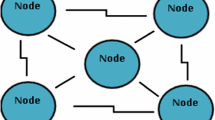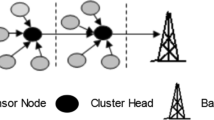Abstract
Ad hoc networks like MANETs can be made manageable by clustering the network where a cluster head is given the responsibility of an arbitrator. To make clustering more efficient, fuzzy clusters can be used to ensure faster cluster formation and reliable data delivery. A wireless sensor network such as MANETs can then have an extended lifetime with the workload being distributed evenly. This paper proposes a competent fuzzy approach in cluster formation. The proposed approach has two significant stages, one which helps in the formation of fuzzy clusters and the other introduces a 3-level filtering technique. The former makes MANETs efficient and manageable and the latter helps in identifying trusted nodes for communication. The modified Fuzzy C-means clustering technique is entrusted with the task of assigning membership to each and every data point linked to each singular cluster center used in the formation of clusters, while a special filter scheme is used to distinguish between the trusted nodes and the malicious nodes. This helps is determining the identity and authenticity of the cluster members’. Eventually only the trusted nodes will be part of the communication range. The filter based fuzzy clustering approach can be used to determine the perfect nodes, which will reflect in the network performance. This also helps in improving the packet transmission in ad hoc networks like MANETs.






Similar content being viewed by others
References
Xia, H., Zhang, R. h., Yu, J., & Pan, Z.-k. (11 March 2016). Energy-efficient routing algorithm based on unequal clustering and connected graph in wireless sensor networks. International Journal of Wireless Information Networks, 23, 1–10.
Zhao, L., & Liang, Q. (January 2005). Distributed and energy efficient self-organization for on–off wireless sensor networks. International Journal of Wireless Information Networks, 12(1), 3–9.
Sathiamoorthy, J. & Ramakrishnan, B. (2017). Energy and delay efficient dynamic cluster formation using hybrid AGA with FACO in EAACK. Wireless Networks, 23(2), 371–385.
Sathiamoorthy, J., Ramakrishnan, B., & Usha, M. (Feb 2015). A reliable and secure data transmission in CEAACK MANETs using distinct dynamic key with classified digital signature cryptographic algorithm. IEEE International Conference on Computing and Communications Technologies (ICCCT).
Lee, J. S. & Cheng, W. L. (Sept. 2012). Fuzzy-logic-based clustering approach for wireless sensor networks using energy predication. IEEE Sensors Journal, 12(9), 2891–2897.
Djatmiko, M., Boreli, R., Seneviratne, A., & Ries, S. (July 2013). Resources-aware trusted node selection for content distribution in mobile ad hoc networks. Springer Journal of Wireless Networks, 19(5), 843–856.
Halabian, H., Changiz, R., Yu, F. R., Lambadaris, I., & Tang, H. (August 2012). Optimal reliable relay selection in multiuser cooperative relaying networks. Springer Journal of Wireless Networks, 18(6), 591–603.
Bouabdallah, F., Bouabdallah, N., & Boutaba, R. (April 2013). Efficient reporting node selection-based MAC protocol for wireless sensor networks. Springer Journal of Wireless Networks, 19(3), 373–391.
Sathiamoorthy, J., & Ramakrishnan, B. (2016). CEAACK—A reduced acknowledgment for better data transmission for MANETs. International Journal of Computer Network and Information Security (IJCNIS), 8(2), 64–71.
Heinzelman, W. B., Chandrakasan, A. P., & Balakrishnan, H. (Oct. 2002) An application-specific protocol architecture for wireless microsensor networks. IEEE Transactions on Wireless Communications, 1(4), 660–670.
Gupta, I., Riordan, D., & Sampalli, S. (2011). Cluster-head election using fuzzy logic for wireless sensor networks. In Proceedings of annual conference on communication Network Services Research, pp. 255–260.
Kulkarni, R. V., Forster, A., & Venayagamoorthy, G. K. (2011). Computational intelligence in wireless sensor networks: A survey. IEEE Communications Surveys & Tutorials, 13(1), 68–96.
Taheri, H., Neamatollahi, P., Younis, O. M., Naghibzadeh, S., & Yaghmaee, M. H. (Sept. 2012). An energy-aware distributed clustering protocol in wireless sensor networks using fuzzy logic. Journal of Ad Hoc Networks, 10(7), 1469–1481.
Kao, Y. & Chen, C. C. (16 June 2012). A differential evolution fuzzy clustering approach to machine cell formation. Springer-International Journal of Advanced Manufacturing Technology, 65(9), 1247–1259.
Attar, A., et al. (2012). A survey of security challenges in cognitive radio networks: solutions and future research directions. Proceedings of the IEEE, 100(12), 3172–3186.
Yan, Z., et al. (2014). A survey on trust management for internet of things. Journal of Network and Computer Applications, 42, 120–134.
Yang, H., et al. (2014). Provably secure three-party authenticated key agreement protocol using smart cards. Computer Networks, 58, 29–38.
Zhou, J., et al. (2015). 4S: A secure and privacy-preserving key management scheme for cloud-assisted wireless body area network in m-healthcare social networks. Information Sciences, 314, 255–276.
Fadlullah, Z. M., et al. (2010). DTRAB: Combating against attacks on encrypted protocols through traffic-feature analysis. IEEE ACM Transactions of Networking, 18(4), 1234–1247.
Yao, G., et al. (2015). Passive IP trace back: Disclosing the locations of IP spoofers from path backscatter. IEEE Transactions on Information Forensics and Security, 10(3), 471–484.
Liu, B., et al. (2014). Toward incentivizing anti-spoofing deployment. IEEE Transactions on Information Forensics and Security, 9(3), 436–450.
Jing, Q., Vasilakos, A. V., Wan, J., Jingwei, L., & Qiu, D. (2014). Security of the internet of things: Perspectives and challenges. Wireless Networks, 20(8), 2481–2501.
Acampora, G., et al. (2010). Interoperable and adaptive fuzzy services for ambient intelligence applications ACM transactions on autonomous and adaptive systems (TAAS), 5(2), 8.
Youssef, M., et al. (2014). Routing metrics of cognitive radio networks: A survey. IEEE Communications Surveys and Tutorials, 16(1), 92–109.
Dvir, A., & Vasilakos, A. V. (2011). Backpressure-based routing protocol for DTNs ACM SIGCOM. Computer Communication Review, 41(4), 405–406.
Zhang, X. M., Zhang, Y., Yan, F., & Vasilakos, A. V. (2015). Interference-based topology control algorithm for delay-constrained mobile Ad hoc networks. IEEE Transactions on Mobile Computing, 14(4), 742–754.
Shakshuki, E. M., Kang, N., & Sheltami, T. R. (March 2013). EAACK—A secure intrusion-detection system for MANETs. IEEE Transactions on Industrial Electronics, 60(3), 1089–1098.
Nayak, C. K., Abani Kumar, G. K., Parida, K. & Das, S. (2011). Detection of routing misbehavior in MANET with 2ACK scheme. International Journal of Advanced Computer Science and Applications (IJACSA), 2(1). doi:10.14569/IJACSA.2011.020119.
Balakrishna, R., Muralimohan Reddy, M., Rajeswar Rao, U., Ramachanndra, G. A. (6–7 March 2009). Detection of routing minbehavior in MANET using 2ACK. In IEEE International Advance Computing Conference (IACC 2009), Patiala, India.
Manvi, S. S., Bhajantri, L. B., & Vagga, V. K. (April 2010). Routing misbehavior detection in MANETs using 2ACK. Journal of Telecommunication and Information Technology, 105–111.
Manikandan, P., & Selvarajan, S. (December 2015). Multi-objective clustering based on hybrid optimization algorithm (MO-CS-PSO) and it’s application to health data. Journal of Medical Imaging and Health Informatics, 5(6), 1133–1144.
Author information
Authors and Affiliations
Corresponding author
Rights and permissions
About this article
Cite this article
Sathiamoorthy, J., Ramakrishnan, B. A Reliable Data Transmission in EAACK MANETs Using Hybrid Three-Tier Competent Fuzzy Cluster Algorithm. Wireless Pers Commun 97, 5897–5916 (2017). https://doi.org/10.1007/s11277-017-4817-8
Published:
Issue Date:
DOI: https://doi.org/10.1007/s11277-017-4817-8




